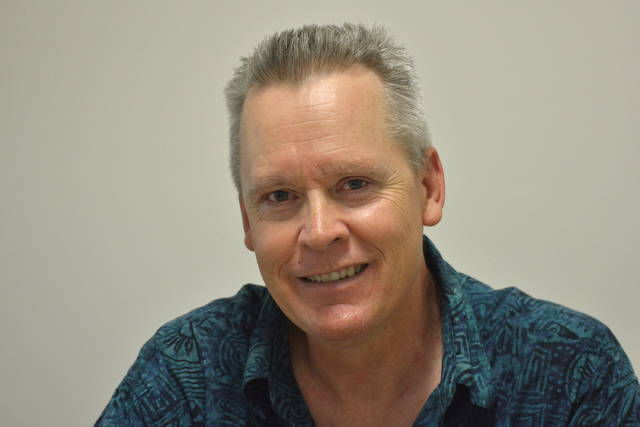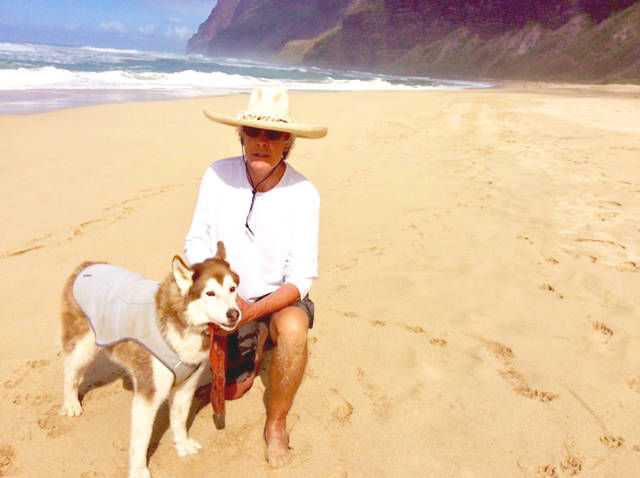With a cane in his right hand, Douglas Glasscock can support his 6-foot, 4-inch frame when he stands. It wasn’t that way six years ago. “I was in great shape, top 25 percent of my age group in terms of
With a cane in his right hand, Douglas Glasscock can support his 6-foot, 4-inch frame when he stands.
It wasn’t that way six years ago.
“I was in great shape, top 25 percent of my age group in terms of strength and stamina,” the Poipu man said of his 2011 self. “But then I started feeling flu symptoms coming on and progressively kept feeling worse and worse.”
Glasscock doesn’t remember going to the hospital; he felt so ill that his neighbor had to take him. A bone marrow biopsy, which Glasscock said was painful beyond belief, revealed that he was suffering from acute erythroleukemia, a rare form of leukemia.
As horrified as he was by the diagnosis, Glasscock wasn’t as shocked as others might be. After all, it’s the same form of leukemia that claimed his father in 2001 and his mother in 2008.
Glasscock lived most of his life either on or near the Navajo Nation, a Native American territory occupying portions of northeastern Arizona, southeastern Utah and northwestern New Mexico. In the 1950s, above-ground nuclear testing was a common occurrence in Nevada, and continued until 1963. But even though testing stopped 54 years ago, the effects of the radiation continued.
“When they tested, it would go up into the stratosphere with countless microscopic metals,” Glasscock said. “And what goes up, must come down.”
But Glasscock and his family did not understood what was going on until the Department of Justice brought to life the Radiation Exposure Compensation Act of 1990, which paid $50,000 per incident to fallout victims who were able to show correlations between certain diseases and their personal exposure to nuclear testing.
Living outside of Nevada, Glasscock and his parents were classified as downwinders, people who were exposed to radiation floating downwind to Arizona, where he was born.
“My dad had already passed but he was eligible and my mom was entitled to $50,000, too. But that’s nothing in long run,” he said. “Lots of Navajo Indians are getting types of leukemias and thyroid cancers. Obviously lots of people are getting this. If attorneys are putting out ads and the government is giving out money, something’s happening.”
After being diagnosed, Glasscock was treated at the University of Colorado hospital and spent 100 days in a hospital bed.
“They basically brought me back to life and then I was in remission. I had never been sick, never really been in a hospital, so after 100 days, I lost 30 pounds and just wanted to get the hell out of there and go back home to my life,” he said. “I rolled the dice to never get sick again and trust that they had this conquered. I had a 50/50 chance that (the cancer) was going to come back.”
His home in Colorado was at an elevation of 8,700 feet. The thin air, plus the cold weather, made it difficult for him live in remission.
“We always came to Kauai for our vacations, so my wife (Tana) and I moved to Kauai in summer of 2013,” Glasscock said. “It worked out great. I’m living here at a low altitude; I was feeling much better.”
But in February 2014, he began experiencing irregular heartbeat and chest pains.
“I didn’t connect it to the leukemia or anything. I thought I was developing heart problems from all the treatments I was getting,” he said. “I went to Wilcox (Medical Center) and did another bone marrow biopsy, and they said the leukemia was back.”
Glasscock returned to Denver, back to the hospital bed he dreaded. For 163 days, he went through radiation treatment again.
“They gave me a bone marrow transplant with two different keiki. I don’t know who they are, but one day I hope I find out,” he said.
Glasscock returned to Kauai in October 2014.
“Now, my health is pretty good. I can’t go into a swimming pool or get a cut or scratch because I have a compromised immune system. I’m achy all the time, I feel like I have the flu all the time without the symptoms of the flu,” he said. “But I’m with my dog, my wife has great insurance, I have no complaints.”
With his cancer in remission for the second time, the 56-year-old is researching downwinders. He wants to know how people might have been affected in Japan in the 1940s because of the Nagasaki and Hiroshima bombings. His goal is to spread awareness regarding the risks of being a downwinder and being exposed to radiation.
“I want to know what happened to those people because I don’t want anyone to have to go through what I did,” he said. “Every day when I was sick in Colorado and in my hospital bed, I would look outside at the Children’s Hospital next door and say to my wife, ‘One day, I hope that’s a hotel.’ I don’t want there to be any need for a kid to be in a hospital. I’m tired of this war machine that’s been happening during my life.”
Not knowing why he survived being at death’s door twice, Glasscock has a feeling that maybe this is his new purpose.
When he feels better and can travel without restriction, he hopes to visit Japan and meet survivors and families of the Nagasaki and Hiroshima bombings.
“Who else is out there that was in my situation, wondering why they got leukemia? I knew why because the Department of Justice was real quick to contact my family,” he said. “We can stop this thing before it ever happens again.”
Exposing people to radiation without them knowing is the worst death sentence he can imagine, Glasscock said.
“I was a man in a bubble,” he said. “The hospital wouldn’t allow anyone under 12 in to see me, so I couldn’t see my grandson. No one could come near without a mask or gloves. I couldn’t breathe, I couldn’t move. At the time, It was like being buried alive in a coffin. And I don’t want anyone to go through that.”



